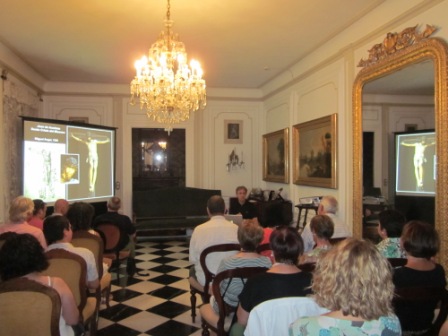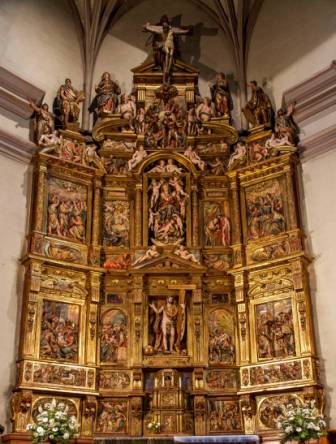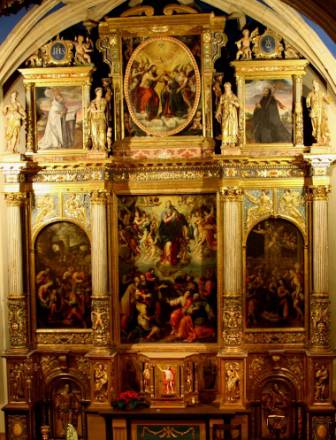September 5, 2014
Global Seminars & Invited Speaker Series
ROUTE OF THE RENAISSANCE OF NAVARRA
Two Italian-style Renaissance altarpieces in Tafalla
D. Pedro Luis Echeverría Goñi
University of the Basque Country
The transition from the leave Age average to the Renaissance in Tafalla did not take place with the conquest of the Kingdom in 1512, nor in 1521 with the destruction of its walls and the royal palace, but from 1529, the date of the restitution of degree scroll of marshal of Navarre and its goods to Pedro de Navarra y de la Cueva by Carlos I. The first work that we can describe as Renaissance in the town of Cidacos was precisely the palace of the Marshals of Navarre, with a turreted façade built in the second third of the century that resembles those of the palaces of Monterrey in Salamanca and of the Guzmanes in León. Its materials from the destroyed royal palace and its plastic elements confirm its adherence to this new language, such as the balls, the Franciscan cord and the chains on the cornice. This typology, like that of its replica, the Azpilicueta palace in Barásoain (originally with four towers), reminds us of the Alcazars, since they also served as accommodation for kings and members of the royal family on their travels.

The lecture was held at the Palacio de los Mencos in Tafalla.
However, we must wait until the last third of the sixteenth century during the reign of Philip II to find two of the most outstanding sets of the Renaissance in Navarra, the altarpieces of the churches of San Pedro, from the monastery of La Oliva, and Santa Maria, exemplary exponents of international Mannerism in painting and sculpture respectively. Their canvases, carvings and reliefs allow us to travel through Rome, Florence and Venice without leaving Tafalla.
Although Juan de Anchieta was never in Italy, he became one of the most influential followers of Michelangelo, with whose art he identified himself after his apprenticeship with Juan de Juni, his contacts with Gaspar Becerra and always through drawings and engravings. The known data of P. Schepers and R. Mois from J. Martínez, were qualitatively expanded by Morejón with documents that contribute new biographical data and works that place them in Rome and Naples.
The altarpiece of Santa Maria, executed by Juan de Anchieta between 1581 and 1588 and completed in 1592 by his disciple Pedro Gonzalez de San Pedro, is an "architectural machine" that refers us through its lexicon to the schemes of Michelangelo, Serlio and Palladio with original inversions of elements. The protagonism of the Virgin in the Marian program of this altarpiece is such that even two apocryphal stories are included in the paschal cycle to justify the presence of the Mother of Christ in them. García Gainza rightly valued this altarpiece in other aspects, I wanted to propose this lecture identifying and analyzing the graphic models used by these two masters of the gouge. Along with the undoubted references to Michelangelo's prototypes, we have pointed out the inspiration in models by Parmigianino, J. Sansovino, T. Zuccaro or Muziano and engravings by C. Cort and N. Beatrizet. The reinterpretation of Dürer's eternal engravings served González de San Pedro to realize several of the reliefs of the Infancy and above all of the paschal cycle. The tabernacle-exhibitor is a three-story micro-architecture that develops on its fronts an exceptional Eucharistic program with the seven most explicit prefigurations of the Old Testament, to which must be added the most unusual scene of Christ's Descent into the Limbo of the Patriarchs, painted on the doorway by Juan de Landa. With solid foundations in the evangelists, Fathers of the Church and apostles, our attention is directed to the crowded attic, occupied by an assembly of prophets and saints who dialogue vehemently. The Calvary, summit of the Redemption, is reinforced by the Trinity, an iconography deeply rooted in Navarre. The polychrome of the natural applied by the aforementioned king of arms between 1596 and 1601, especially in the benches and the central street, enhances the carving.

Main altarpiece of the parish church of Santa María de Tafalla
Carried out by Juan de Anchieta and Pedro Gonzalez de San Pedro (1581-1592)
(Photo: Andoni San Juan)
The history of the mixed altarpiece that has presided over the church of San Pedro since 2006 is marked by the itinerancy of almost three centuries in its original destination, the Cistercian church of Santa María la Real de La Oliva in Carcastillo, and a century and a half in the presbytery of the convent church of the Conventual Conceptionist Recollects of Tafalla. Begun in 1571 by the Flemish painters Paulo Schepers and Rolan Mois, residents of Zaragoza, its execution took sixteen years until 1587. Its masonry and carving work are retarded, as evidenced by its columns, balusters and decoration, and its carvings and reliefs show traces of expressivism. In addition, we notice the presence of genuinely Aragonese elements such as the doors that gave access to the dressing room, and the reliquaries that hold the nets, lined with brocade application. The tabernacle is a later Romanesque work of the workshop of Sangüesa and sample in its doorway the Trentine triumphal topic , which is added to the two Resurrected ones of the altarpiece of Santa María. Very beautiful are the colorful natural estofados that shines in its interior with Eucharistic emblems and the trilogy of papers of all the colors.
The symbolic foundations of the Church building that constitutes this altarpiece, i.e., St. Peter and St. Paul, evangelists, Fathers of the Church, the seven virtues and the allegory of peace, were reserved here for the carving work commissioned by the Flemish painters to the sculptor Juan de Rigalte, who followed models provided by them. Our current knowledge allows us to attribute the initiative of this work to Schepers, an outstanding painter and follower of Titian, to whom we can attribute the canvases of the Adoration of the Shepherds and the Epiphany (inverted after erroneous assemblies in Tafalla), as well as the beginning of the Assumption. As in the previous altarpiece, we have made a dissection of the graphic sources used here by the Flemish painters, taking characters and elements from G. Clovio, C. Cort and P. Thomassin. The central canvas of the Assumption, of which a drawing by Mois has been preserved, brings us here great compositions of the Italian Mannerism of Raphael and Titian with the characteristic iridescent palette and a marked division of the earthly and heavenly registers. If in the Virgin we notice great similarities with Assumptions by F. Zuccaro, some of the angels are repeated in paintings by El Greco. Although the paintings of the attic, made by disciples of Mois, are of lower quality, in the Coronation of the Virgin we notice a great identity with the image of the Virgin crowned by Christ of the main altarpiece of Astorga, work of Gaspar Becerra, and with an engraving of the same topic by J. Sadeler I.

Altarpiece of the parish of San Pedro
Executed by the painters Schepers and Mois for the monastery of La Oliva (1571-1587).
